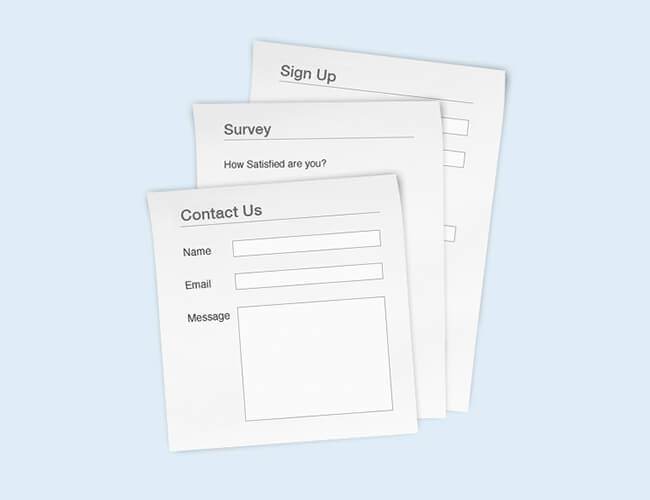Do you ask people to register for your newsletter on the website? Do you have an online application form? Do clients inquire about your services online?
Online forms are a great tool for collecting information from your constituents, however, when they are not integrated with your CRM the process of manually entering the information into the database can be overwhelming.
There are number of ways to integrate your online website forms with Salesforce. How do they compare? We did the leg work for you and below you can find some integrations that have worked for our clients and might work for you as well.
Web to Lead
Native Salesforce functionality that allows generating up to 500 new leads a day.
Pros:
- Easy to create (clicks no code)
- No additional cost
- Only creates leads (cannot update other objects)
- Only creates leads (cannot update other objects)
- You will need a web developer in order to create validations and design of the form (Javascript)
- No de-duplication
- Does not include CAPTCHA
- Unable to accept attacments
Web to Case
Native Salesforce functionality that allows generating up to 500 new cases a day.
Pros:
- Easy to create (clicks no code)
- No additional cost
- Includes limited de-duplication
- Cannot update other objects
Cons:
- Cannot update other objects
- You will need a web developer in order to create validations and design of the form (Javascript)
- Limited de-duplication
- Does not include CAPTCHA
- Unable to accept attacments
Cost: Free (if you do it yourself)
Salesforce Sites
Force.com Sites enables you to create public websites and applications that are directly integrated with your Salesforce organization—without requiring users to log in with a username and password.
Here is an example of a Site.com form: http://teamupmemphis.force.com/
Pros:
- Powerful forms (Sites are much more than just forms!) that can include any business logic and de-duplication processes.
- Can have the same look and feel of your website
Cons:
- Require a force.com developer to create and maintain
- Redirect the user to an external website
Cost: Contact us for a quote.
salesforce visualflows
Visual Workflow allows you to automate business processes by building applications, known as flows, that collect, update, edit, and create Salesforce information, and then make those flows available to your internal users or on your website by adding them to a Site page. Flows can execute logic, interact with the Salesforce database, call Apex classes, and guide users through screens for collecting and updating data. Read more about flows here.
Pros:
- Powerful forms (Sites are much more than just forms!) that can include any business logic and de-duplication processes.
- You can do a lot with flows without any code
Cons:
- Redirect the user to an external website
- You might need a developer to make the flow look like your website
Cost: Contact us for a quote.
Featured Content

The highly-anticipated Summer ’20 Release is finally here! This new NPSP release introduces timely enhancements for user experience and features several innovations to the Lightning

I have a number of connections to the higher education industry: I’m on an EDA team at Cloud for Good; my mom is an admissions counselor at a small liberal
Create powerful web forms to collect and send data to your Salesforce account. Capture new leads, update contacts, attach files or open cases with an easy to use Web Form Builder and Salesforce Connector.
- Create forms for standard and custom Salesforce objects
- Allows to update information in Salesforce and upload files
- Ongoing cost
- Not as flexible as Salesforce Sites
- Burns through API calls (not recommended for large forms)
Formstack
Formstack’s integration with Salesforce.com allows to create online forms for Web-to-lead, Web-to-case, and Web-to-Anything with just a few simple clicks.
Pros:
- Create forms for standard and custom Salesforce objects
- Allows to update information in Salesforce and upload files
- Ongoing cost
- Not on the AppExchnage
- Not as flexible as Salesforce Sites
Cost: Click here for the complete price list.
Wufoo
- Easy to create and map the fields
- The forms include all validations and design therefore, there is no need in a web developer
- Very limited integration, can only create leads and contacts and does not support custom fields in Salesforce
- Not on the AppExchnage
API
- Use the API to update or insert to any object in Salesforce
- Need a developer that is familiar with both your website and Salesforce
Choosing the Right Tool
Start by thinking about your needs. If you’re just looking to collect newsletter registration or simple inquiries Web to Lead forms might work for you. On the other hand, if you’re looking for updating multiple objects in Salesforce and searching for duplicates Salesforce Sites or third party applications are more likely to have the features you need.
Ready to move to the next step? Contact use to receive a quote today.





